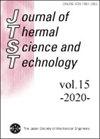Effect of fuel property on the ignition and combustion characteristics of prechamber ignition
IF 0.9
4区 工程技术
Q3 THERMODYNAMICS
引用次数: 1
Abstract
Recently, since international problems such as global warming, air pollution, and energy resource depletion are gradually becoming more serious, combined heat and power and cogeneration systems have been attracting a lot of attention since they can be used as low environmental load power generation systems (Agency for Natural Resources and Energy in Japan, Energy in Japan, 2003). A cogeneration system can recover an engine’s waste heat and provide both heat and electrical energy at the same time, resulting in a high total efficiency of 80%. In Japan, since 65% of the installed cogeneration systems are gas engines and about 49% of the total power generation capacity is fueled by natural gas, increasing the efficiency of natural gas engines, whose efficiency is currently about 40%, enhances the utilization of both heat and electrical energy, thus corresponding to various environmental and customer demands. One of the most effective ways for improving the thermal efficiency of combustion engines and reducing the harmful emissions of undesirable combustion products, such as nitrogen oxides, is the use of lean-burn techniques and exhaust gas recirculation (EGR) (Heywood, 2018). Although such methods have already been in practical use, they still face many technical problems, such as the substantial decrease in the burning velocity and the unstable combustion in the lean or diluted mixture region. To solve these problems, prechamber ignition systems are commonly used in gas engines to improve their inflammability and enhance the combustion characteristics in the lean or diluted mixture region. A prechamber ignition system has a small “prechamber” whose volume is less than 5% of the main chamber’s volume. The combustible mixture is first ignited in the prechamber, resulting in a torch flame that can burn a leaner mixture in the main chamber, where the torch flame is injected from the prechamber into the main chamber. Since the combustion characteristics in gas engines depend on the injected torch Riku YAMASHITA*, Satoshi WAKU*, Daisuke MORI*, Seiya UENO*, Kimitoshi TANOUE* and Yasuo MORIYOSHI** * Oita Univ. Dept. of Mechanical and Energy systems engineering 700 Dannoharu, Oita 870-1192, Japan E-mail: tanoue@oita-u.ac.jp ** Chiba Univ. Graduate School of Engineering 1-33 Yayoicho, Inage Ward, Chiba-shi, Chiba, 263-0022, Japan燃料特性对预燃室点火及燃烧特性的影响
近年来,由于全球变暖、空气污染、能源枯竭等国际问题日益严重,热电联产和热电联产系统由于可以作为低环境负荷的发电系统而备受关注(Agency for Natural Resources and energy in Japan, energy in Japan, 2003)。热电联产系统可以回收发动机的余热,同时提供热能和电能,总效率高达80%。在日本,由于已安装的热电联产系统中有65%是燃气发动机,而总发电能力中约有49%是由天然气提供燃料,因此提高天然气发动机的效率(目前效率约为40%)可以提高热能和电能的利用率,从而满足各种环境和客户需求。提高内燃机热效率和减少有害燃烧产物(如氮氧化物)排放的最有效方法之一是使用稀燃技术和废气再循环(EGR) (Heywood, 2018)。虽然这种方法已经在实际应用中,但仍然面临许多技术问题,如燃烧速度大幅降低,稀或稀混合气区域燃烧不稳定等。为了解决这些问题,通常在燃气发动机中采用预燃室点火系统来改善发动机的可燃性,提高稀混合气区或稀混合气区的燃烧特性。预室点火系统有一个小的“预室”,其体积小于主室体积的5%。可燃混合物首先在预室中点燃,产生火炬火焰,该火炬火焰可以在主室中燃烧较稀薄的混合物,火炬火焰从预室注入主室。由于燃气发动机的燃烧特性取决于注入火炬山下陆*,WAKU Satoshi *, MORI Daisuke *,上野星矢*,田上Kimitoshi *和moriyoyasuo **大分大学机械与能源系统工程系700 Dannoharu, Oita 870-1192, Japan E-mail: tanoue@oita-u.ac.jp **千叶大学工程研究生院1-33 Yayoicho,图像区,千叶,2630022,Japan
本文章由计算机程序翻译,如有差异,请以英文原文为准。
求助全文
约1分钟内获得全文
求助全文
来源期刊
CiteScore
2.30
自引率
8.30%
发文量
0
审稿时长
5 months
期刊介绍:
JTST covers a variety of fields in thermal engineering including heat and mass transfer, thermodynamics, combustion, bio-heat transfer, micro- and macro-scale transport phenomena and practical thermal problems in industrial applications.

 求助内容:
求助内容: 应助结果提醒方式:
应助结果提醒方式:


